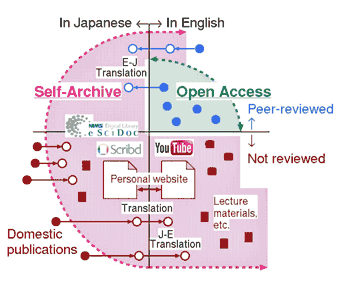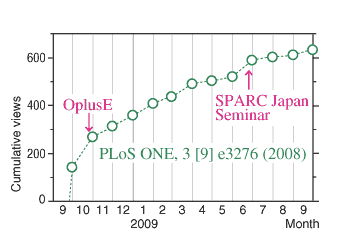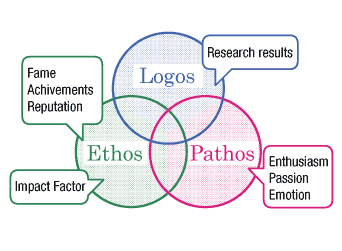
Shin-ichi Todoroki
(National Institute for Materials Science)
According to ‘The STM Report’,1 the proportion of the articles published in open access (OA) journals was estimated to be only a small percentage. Nevertheless, I have been submitting my papers, at least paper of which I am the the principal author, to OA journals.*1 One of the reasons is my motto: “Do as we would be done by”. I would like to read papers without any barriers. Thus, I publish mine as open access. Here, I will discuss the pros and cons of my stance.
Are the Cons Negligible?

Figure 1: Classification chart of my publications. The solid symbols indicate original works; white circles indicate their derivatives.
In most cases, the publication fee for OA journals is higher than that for non-OA ones, but I pay the expense. This policy inevitably limits my choice of journals, but I am fortunate to be able to find some journals appropriate for my specialty. Although there are some specialized research fields upon which the present OA journals have little influence, I believe that the researchers in these fields can find necessary articles in these OA journals through the present search engines.
In addition, I make it a rule to self-archive my publications, except peer-reviewed OA articles, as much as possible. As my self-archived documents often cite my OA articles, they provide opportunities for readers to find my OA articles. I gave a detailed presentation of my self-archiving (SA) activity at the 1st SPARC Japan Seminar in 2009.2 Figure 1 shows a rough outline of this activity and its relationship to my OA publications. My original papers are represented by the solid blue circles in the upper right quadrant (peer-reviewed journals in English). Some of my non-OA articles, which are shown outside the green area, are self-archived to the extent permitted by my rights as an author.
For SA, I use NIMS eSciDoc,*2 the digital library of my institute, and Scribd,*3 a document-sharing website. I self-archive my slides, posters, and other lecture materials, as well as translations of my papers that were prepared of necessity. Whenever I contribute an article to a domestic journal that is circulated as printed media, I negotiate with the editor for permission to publish it by SA. I also use YouTube for publishing videos that are prepared in the course of my research activities.*4 All the links to these materials are compiled on my personal website and organized by topic.*5 Thus, I have created a citation network of my self-archived materials that leads my readers to my OA papers as far as possible.
Notes
*1 This includes journals that allow authors to publish their article as OA.
*2 http://pubman.mpdl.mpg.de/pubman/faces/HomePage.jsp;jsessionid=325C5EF71895914606F3A6646C7046CC
*3 http://www.scribd.com/tdrks
*4 http://www.youtube.com/Tokyo1406
*5 http://www.geocities.jp/tokyo_1406/
In addition, the following links may be useful, although they are less frequently updated.
http://researchmap.jp/tokyo1406/?lang=english (Researchmap)
http://nims.academia.edu/Shin-ichiTodoroki (academia.edu)
http://www.researcherid.com/rid/A-9922-2008 (ResearcherID)
http://read.jst.go.jp/public/cs_ksh_008EventAction.do?action4=event&lang_act4=E&judge_act4=2&knkysh_name_code=5000000697 (ReaD)
http://www.sangakuplaza.jp/page/143087/ (Sangaku Plaza researcher DB)
Furthermore, NIMS eSciDoc is scheduled to provide a service to update researchers regarding blogs and ReseacherID pages when they post their articles to the repository (see http://todoroki.blogs.mpdl.mpg.de/)3.
Are the Pros Practical?
 Figure 2: Cumulative views of my OA article published
in PLoS ONE 7
Currently, it is almost impossible for authors to quantify the benefit of publishing their articles by OA. However, from my experiences with SA, I am convinced of the benefit of enhancing the readership beyond my specialty. This is confirmed by an analysis of the usage statistics for my SA materials.
I have found that the SA version of my paper published in a materials science journal three and a half years ago4 was gaining over 100 views per month and was read by linguists.2 I also noted that a small percentage of viewers of my YouTube video visited my website to access related documents.5
Similar analysis is not possible for OA papers, since authors of such papers cannot view their access logs. However, in September 2009, PLoS began providing per-article usage statistics in seven OA journals. I happened to have published an article in PLoS ONE the previous year.6 I admit that the paper had barely any impact since it was rejected earlier by a journal for rapid communication. Nevertheless, I cited and introduced the paper later in an article and a lecture given in Japanese and self-archived them in order to gain a wider readership because the paper contains some movie files and a Japanese translation that attract the attention of readers beyond my specialty. Thus, I had an unexpected opportunity to discover how many people had looked up the paper in responce to my PR activities.
Figure 2 displays the cumulative views of my paper on a monthly basis. Even though PLoS ONE is seldom read by the researchers in my field, my article gained almost 300 views in the first month. This is probably because of the citation from my Japanese article published in late October in a domestic journal (official circulation figures: 13,500).7 It is interesting to see a small increase after my lecture in the SPARC Japan Seminar in late June.2 In addition, the views definitely include readers from my YouTube video and other SA materials. If I had not published the paper by OA, I do not have gained as many views.
Why Pursue OA and SA?
 Figure 3: Aristotle’s three means of persuasion and their breakdown for research publications.
Figure 3: Aristotle’s three means of persuasion and their breakdown for research publications.
I have two more reasons in favor of OA and SA apart from the ones I have listed in the beginning. One is that my recent research includes some phenomena that would be eye-catching to the general public. People let out cries of surprise when they see a demonstration of “fiber fuse,” in which an optical fiber is destroyed by strong light (see the video of my lecture2 from 6:10 to 7:00 minutes). Further, in this work, I have frequently benefited from serendipity, or the ability to make the best use of accidental discoveries.8 I would like to share my experiences with various people beyond my specialty. Thus, I want to make my publications freely accessible.
The second reason is to express my gratitude to the public that has given me a longstanding benefit. As a graduate student at the dawn of the Internet era in Japan, I had the opportunity to use a UNIX-compatible operating system through mainframe computers and enjoyed the associated culture. Since then, I have benefited from free software such as LaTeX, GNU/Linux, and Ruby throughout my research career. Since I am not a software developer, the best way to repay this debt is to make my publications freely accessible to the public.
Of course, my stance toward OA is but one of many possible stances. In order to provide a relative view of these stances, I utilize Aristotle’s three means of persuasion: Ethos, Pathos, and Logos (see Figure 3).
Researchers rely on Logos (logic) as the basis for presenting their findings. However, no communication occurs in the absence of readers. Therefore, the stance toward OA depends on the strategy that the author uses to gain his/her readership. For some researchers, the top priority is to eliminate any barriers of accessibility; for others, it is to attract readers through his/her Ethos, or the credibility of the source. These two are not mutually exclusive, but they are not altogether compatible either. The Impact Factor (IF) is an Ethos of academic journals, not the author.
Once a reader begins reading an article, persuasion by means of Pathos also becomes effective. If the reader is impressed, the author will ultimately gain in terms of Ethos.
How should we approach OA? I hope this article will encourage researchers to think anew regarding their own stance toward OA, which is still in its infancy compared to the long tradition of scholarly communication. Lastly, I would like to thank Ms. Yuko Nagai of the Zoological Society of Japan and Ms. Mikiko Tanifuji of the National Institute for Materials Science (NIMS) for their valuable comments on previous drafts of this article.
References
| 1. |
Ware, M; M. Mabe, M. “The STM report: An overview of scientific and scholarly journals publishing”. Oxford, UK, Technical report, International Association of Scientific, Technical and Medical Publishers, 2009.
http://www.stm-assoc.org/2009_10_13_MWC_STM_Report.pdf |
| 2. |
Todoroki, S. “Dakara serufu ākaibingu wa yamerarenai! ” (My joy of self-archiving). 1st SPARC Seminar 2009, “Kenkyūsha wa hasshin suru: Tayō na jōhō shudan o mochii, shakai e no hirogari o motomete” (“Voluntary publication from researchers through a variety of network media in the quest for dissemination to the general public”). http://www.nii.ac.jp/sparc/event/2009/20090625.html |
| 3. |
Takaku, M. “NIMS eSciDoc: Kokunai ni okeru tenkai” (“NIMS eSciDoc: A feedback from Japanese aspect”). Digital Repository Federation (DRF) Technical Workshop: Gijutsu to kenkyu ga deau tokoro wa (Where technology and research meet), “Workshop of Application of Repository Infrastructure for eScience and eResearch: Kenkyu seika ya deta o eikyu hozon shite iku katsudo e mukete (Toward the development of a permanent repository of research findings and data).” http://drf.lib.hokudai.ac.jp/drf/index.php?DRFtech-Kyoto |
| 4. |
Todoroki, S;Konishi, T; Inoue, S. “Blog-based research notebook: personal informatics workbench for high-throughput experimentation”. Applied Surface Science. vol. 252, issue 7, 2006, p. 2640-2645.
http://pubman.mpdl.mpg.de/pubman/item/escidoc:28315 |
| 5. |
Todoroki, S. “Faiba hyūzu no dōga ni totsuzen chūmoku ga atsumatta koto no tenmatsu” (“Why my fiber fuse video suddenly attracted engineers’ attention”). Materiaru Integurēshon (Materials Integration) . vol. 22, no. 11, 2009, p. 67-69. http://pubman.mpdl.mpg.de/pubman/item/escidoc:108043
|
| 6. |
Todoroki, S. “In situ observation of modulated light emission of fiber fuse synchronized with void train over hetero-core splice point”.
PLoS ONE, 3, 9, 2008, p. e3276 (2008). http://dx.doi.org/10.1371/journal.pone.0003276 |
| 7. |
Todoroki, S. “Hikari faibā no jikai rensa genshō: Faibā hyūzu” (“Fiber fuse: Sequential self-destruction of optical fibers”).
O plus E. vol. 30, November issue, 2008, p. 1188-91. http://pubman.mpdl.mpg.de/pubman/item/escidoc:39033 |
| 8. |
Todoroki, S. “Chance favors the prepared mind”. 2009.
http://pubman.mpdl.mpg.de/pubman/item/escidoc:54210 |
|

